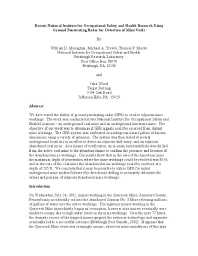Mining Publication: Recent National Institute for Occupational Safety and Health Research Using Ground Penetrating Radar for Detection of Mine Voids
Original creation date: July 2003
We have tested the ability of ground penetrating radar (GPR) to resolve adjacent mine workings. The work was done at two NIOSH locations: an underground coal mine and an underground limestone mine. The goal was to determine if GPR signals could be received from distant mine workings. The GPR system was calibrated on underground mine pillars of known dimensions using a variety of antennas. The system was then tested at several underground locations in an effort to detect an adjacent drift entry and an adjacent abandoned coal mine. As a means of verification, an in-seam horizontal hole was drilled from the active coal mine to the abandoned mine to confirm the presence and location of the abandoned mine workings. Results show that in the case of the limestone mine, the maximum depth of penetration where the mine workings could be resolved was 85 ft; in the case of the coal mine, the abandoned mine workings could be resolved at a depth of 205 ft. We conclude that it may be possible to use GPR for initial underground mine studies followed by directional drilling to accurately delineate the extent and position of adjacent abandoned mine workings.
Authors: WD Monaghan, MA Trevits, TP Mucho, J Wood
Conference Paper - July 2003
NIOSHTIC2 Number: 20023642
Geophysical Technologies for Detecting Underground Coal Mine Voids: An Interactive Forum. Washington, DC: U.S. Department of Transportation, Federal Highway Administration, 2003 Jul; :1-28
See Also
- Diagnosing and Controlling Moisture-Sensitive Roof in Coal Mines
- Progress Toward Improved Engineering of Seals and Sealed Areas of Coal Mines
- Refuge Alternatives in Underground Coal Mines
- Safe and Economical Inerting of Sealed Mine Areas
- SPONCOM - A Computer Program for the Prediction of the Spontaneous Combustion Potential of an Underground Coal Mine
- Technology News 535 - NIOSH Releases New Educational Video: Escape from Farmington No. 9: An Oral History
- Technology News 545 - NIOSH Updates Spontaneous Combustion Assessment Software
- Ultra-Low Frequency Through-the-Earth Communication Technology
- Wireless Mesh Mine Communication System
- Work Sampling Applied to a Human Factors Analysis of Mine Worker Positioning
- Page last reviewed: 9/21/2012
- Page last updated: 9/21/2012
- Content source: National Institute for Occupational Safety and Health, Mining Program


 ShareCompartir
ShareCompartir
